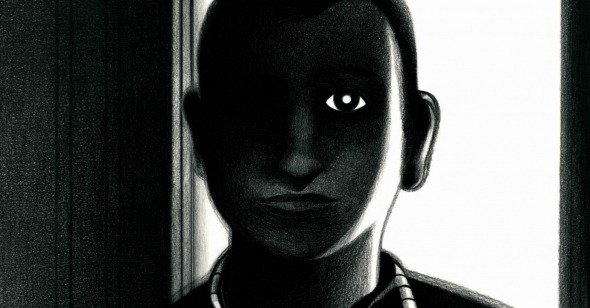Army of Shadows
By Michael Koresky
Fear(s) of the Dark
Various Directors, France, IFC Films
Like any omnibus film, the Christophe Jankovic and Valérie Schermann–produced French collection of creepy, crawly cartoon shorts, Fear(s) of the Dark, succeeds on the strength of its best components. Though it seems that in animation it’s easier to convey an “idea” of fear to an audience than impart in the viewer fear itself, the film nevertheless pleasantly lodges in the brain. A persuasive showcase for a handful of contemporary animators, Fear(s) is comprised of mostly beautifully designed segments which get exponentially better as the film continues, going deeper and deeper into an ever darkening rabbit hole. Like the famed sixties compilation Spirits of the Dead, which wisely saved Fellini’s astonishing “Toby Dammit” for its just-desserts course, Fear(s) of the Dark sends us out on a high, low note.
Animation’s ability to unsettle has been superbly exploited over the past century in everything from the brilliant “Night on Bald Mountain” sequence in Fantasia to the loopy, otherworldly beasties Max Fleischer would devise to chase poor Betty Boop (not scary? Try watching a “Fleischer Folio” at 2 a,m. with the lights out). Though I’ve yet to see any moving illustrations that have equaled in terror the despairing drawings done by Stephen Gammell in the “children’s” series Scary Stories to Tell in the Dark (those pictures that look splattered across the page with black blood still haunt many of us from grade-school), the ability to so dramatically employ shadow and light and conjure any horrific bit of imagination leaves the possibilities for animated terror wide open. Cronenbergian “body horror” might never translate well to such a canvas, however, as evidenced by the Adrian Tomine-esque opening section of Fear(s), a minor tale of an introverted insect-collector who meets his comeuppance at the hands of an erratic, threatening femme fatale. Though its misogyny is both the point and at the same time unexamined, this segment, from Richard Burns, does at least climax with a disquieting bit of grotesquerie.
None of the segments here have the sort of narrative force one would desire from good short fiction (imagine an animated adaptation of Hawthorne’s “Young Goodman Brown” to envision what we’re missing here in terms of story or allegory), but a couple of them more than make up for it in the clarity of their design. These aren’t stories but ephemera, bits and pieces of dissociated terror, best exemplified by the uncannily creepy and appealingly metaphoric section drawn by artist Blutch—in which a desiccated, demon-faced aristocrat scours the countryside with a pack of ravenous dogs, unleashing them on a cross-section of bedraggled common folk—which is cut into smaller chapters sandwiched in between each of the other episodes. Though brief and single-minded, Blutch’s frightening, fluid line drawings recall Richard Williams’s outstanding work on the 1971 animated short A Christmas Carol (which contains film’s most literally jaw-dropping incarnation of Jacob Marley)—high praise, indeed.
A more unfortunate structuring device is the use of deflatingly ironic interstitial segments designed by Pierre di Sciullo, in which an off-screen voice (Nicole Garcia), over images that veer from Rorschach blotches to geometric patterns, delineates her fears, which range from “dining on plump wriggling worms on a plate” to tongue-in-cheek liberal bourgeois paranoia, like “I am increasingly susceptible to conservative argument…Maybe I’m center-left?” These seem increasingly employed to pad the film out to feature length; without them we could get to the good stuff faster. Marie Caillou and Romain Slocombe’s anime-inspired tale of a girl haunted by a samurai ghost is negligible (the summoning of spirits in a dream sequence evokes nothing so much as Winnie the Pooh’s Heffalumps and Woozles); but Lorenzo Mattotti’s abstract, nightmarish, charcoal-grey depiction of the hunt for a killer beast in a small village is the one that feels most gratifyingly like a great children’s picture book (the image of a single, sacrificial goose tied to a stake as the sun goes down is indescribably eerie), and Richard McGuire’s pièce de resistance, a wordless haunted-house thriller told only through various imaginative formations of inky blacks and blinding whites, stuns with its gorgeously designed ambiguity.
